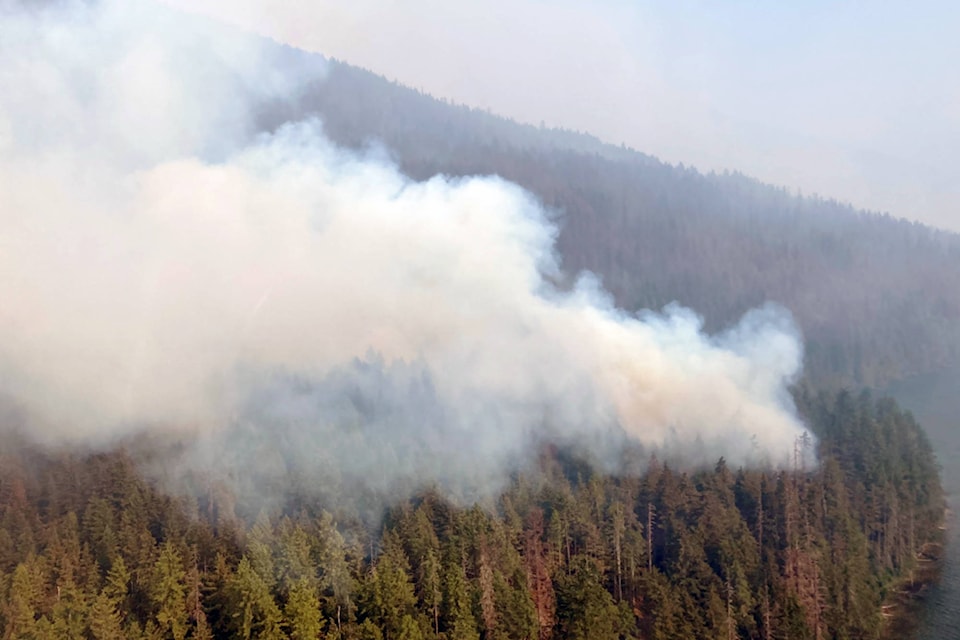Update: 10:54 a.m., July 17
Firefighters from Salmon Arm have been deployed to Seymour Arm with a structural protection unit.
The crew will assist with setting up sprinklers and protecting infrastructure.
A different structural protection unit and crew from Salmon Arm will also be heading to Kamloops on Saturday, again to set up sprinklers and help protect infrastructure.
The Columbia Shuswap Regional District’s (CSRD) Shuswap Emergency Response program shared the information on Twitter this morning, along with photos of the firefighters.
Two Structural Protection Units left Salmon Arm Saturday morning, July 17, with one deployed to Seymour Arm and another to Kamloops to replace a previous CSRD crew. These crews come in on-call to assist with setting up sprinklers and helping to protect infrastructure.#SEP #CSRD pic.twitter.com/RHe2ObEgtH
— Shuswap Emergency Program (@shuswapemerg) July 17, 2021
The Hunakwa Lake wildfire is still measured at 1,100 hectares in size and is classified as out of control.
According to the BC Wildfire Service, the fire was caused by lightning.
The community of Seymour Arm remains on evacuation alert.
More to come.
Update: 5:20 p.m., July 16
An aerial survey of the Hunakwa Lake fire shows it’s somewhat smaller than estimated, but continues to grow.
In a second July 16 update on the wildfire that prompted the July 14 evacuation order for the community of Seymour Arm, the Columbia Shuswap Regional District said the B.C. Wildfire Service has determined the Hunakwa Lake fire to be about 1,100 hectares in size, and approximately 3.7 kilometres away from the nearest structure. The fire is said to be exhibiting Rank 2 fire behaviour, with open flame and a slow rate of speed. While it continues to grow, the main area of growth is occurring away from the community.
Original story:
A wildfire near a Shuswap community on evacuation alert has once again doubled in size.
According to a Friday, July 16 media release from the Columbia Shuswap Regional District (CSRD), the Hunakwa Lake fire is now at approximately 1,250 hectares in size. The night prior the fire increased from 230 to 650 hectares.
The nearby community of Seymour Arm remains on evacuation alert, which was issued July 14.
“Residents and any remaining visitors need to be prepared for evacuation on short notice,” the CSRD advised.
According to the regional district, the BC Wildfire Service is working with other agencies and private industry on “planning and placement of a machine-built fire guard to assist in the protection of the community of Seymour Arm.”
On July 14, the CSRD announced three fire crews were being deployed to Seymour Arm to assist with fire protection.
Read more: CSRD sends fire crews to help protect Seymour Arm during evacuation alert
Read more: Evacuation alert for Seymour Arm still in place as wildfire nearly triples in size
“These crews are on site and ready to deal with any community protection efforts, as needed,” reads the July 16 release.
Furthermore, a structural protection unit is also being deployed. It includes five structural firefighters, two vehicles and a trailer equipped with water sprinkling systems.
The CSRD says its FireSmart representatives have also travelled to Seymour Arm to provide advice and information to property owners about how to reduce their fire risk to their home and property.
Seymour Arm residents are being encouraged to self-register with Emergency Support Services online at https://ess.gov.bc.ca/. When registering, please indicate the community as Seymour Arm.
The CSRD says this step is critical as it provides important information in case of an evacuation.
For evacuation grab-and-go bags, residents are advised to pack up at least one week’s worth of clothing and toiletries. Vehicles should be kept filled with gas. With accommodations in the Shuswap limited at this time, arrangements should be made to stay with family and friends, if possible, says the CSRD.
lachlan@saobserver.net
Like us on Facebook and follow us on Twitter
Sign up for our newsletter to get Salmon Arm stories in your inbox every morning.
